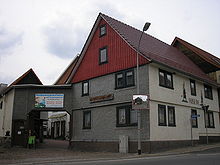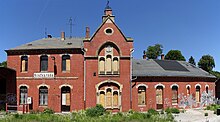Graefenroda
|
Graefenroda
Rural community of Geratal
|
|
|---|---|
| Coordinates: 50 ° 44 ′ 56 " N , 10 ° 48 ′ 44" E | |
| Height : | 400 m |
| Area : | 23.31 km² |
| Residents : | 3158 (December 31, 2017) |
| Population density : | 135 inhabitants / km² |
| Incorporation : | 1st January 2019 |
| Postal code : | 99330 |
| Area code : | 036205 |
|
Grevenrot House
|
|
Gräfenroda is a district of the rural community Geratal in the Ilm district ( Thuringia ).
geography
location
Graefenroda is about 400 meters above sea level in the valley of the Wild Gera , is the largest place without city rights in the Ilm district and the fourth largest town in the district in terms of inhabitants. With a length of five kilometers, the place is also the longest village in the district. To the north of Gräfenroda rises the 490 meter high Läusebühl, to the south lies the 508 meter high Gräfenrodaer Berg. The Thuringian Forest begins southwest of the village . The Lütschetalsperre is located west of Graefenroda . The Lütsche flows into the Wilde Gera in Graefenroda. Up the valley, 3 km away, the Wilde Gera viaduct is the most imposing bridge on the A 71 .
Neighboring places
Clockwise, starting in the north: Liebenstein , Geschwenda , Geraberg , Gehlberg , Oberhof , Frankenhain
history
Gräfenroda was first mentioned in a document in 1290 . The place name identifies the place as a clearing settlement. The property on site was originally held by the Counts of Kevernburg and Schwarzburg , respectively , from 1446 to 1819 the property was divided into a Schwarzburg and a witzlebisch , later a Gothic half. Traditional ways of earning a living for the inhabitants were in forestry and haulage, as well as in the mining of copper, silver and lead and, from the 16th century, in glass production. In the 17th century the districts of Anspiel and Dörrberg emerged as development settlements in connection with the construction of smelting works and hammer mills. The pre-industrial companies, however, only offered few jobs, so that in the middle of the 19th century many residents emigrated to America because of the lack of employment opportunities. Only after 1850, in the course of industrialization, did larger businesses settle in the village: a wood goods factory in 1855, a terracotta factory in 1860, a glassworks in 1869 and later other porcelain factories. In 1884 it was connected to the Neudietendorf – Ritschenhausen railway line . At the end of the 19th century, the garden gnomes were born in Graefenroda and can now be viewed in a museum. From 1858 to 1922, Graefenroda belonged to the District Office of Ohrdruf in the Duchy of Saxony-Coburg and Gotha .
In the years of the Second World War , 104 “ Eastern workers ” had to do forced labor at the Hugo Funk Söhne company and in the Wilhelmshütte glass factory . In the churchyard, graves and a plaque commemorate two concentration camp prisoners who were shot by SS members during a death march near Gräfenroda . During the Nazi era, the writer Artur Dinter , who was notorious for his anti-Semitic propaganda, lived and worked in Graefenroda. In 1945 he fled to Zell am Harmersbach to avoid punishment.
During the GDR era, the VEB Matratzenfabrik Wittekind built and maintained a holiday camp for the children of its employees in Halle .
Since 1994 Gräfenroda has belonged to the Ilm district and from 1993 it was the seat of the Upper Geratal administrative association . With the dissolution of the administrative community, Gräfenroda became part of the rural community of Geratal on January 1, 2019.
Population development
Development of the population:
|
Data source: from 1994 Thuringian State Office for Statistics - values from December 31st
politics
(District) mayor and district council
The district mayor of Gräfenroda is Dominik Straube ( CDU ). Together with ten other members, it forms the local council. Straube was elected honorary mayor of the then still independent municipality on May 7, 2017, after the incorporation in Geratal he will hold the office of local mayor for the rest of his term of office. In addition, he was elected full-time mayor of the rural community of Geratal on May 26, 2019.
From 1994 to 2006 Norman Höhler (first FDP, then CDU) was the mayor of Graefenroda, before Frank Fiebig (Die Linke) followed from 2006 to 2017. Until 2000 the office of mayor was full-time, since then it has been carried out on a voluntary basis.
Previous election results
The last 3 elections to the municipal council in Gräfenroda resulted in the following results:
| Party / list | Share of votes in 2014 | Seats 2014 | +/− seats in 2014 | Share of votes in 2009 | Seats 2009 | +/− seats in 2009 | Share of votes 2004 | Seats 2004 | ||
| CDU | 42.1% | 7th | + 1 | 33.8% | 6th | - 3 | 52.1% | 9 | ||
| The left | 26.1% | 4th | 0 | 26.2% | 4th | + 2 | 12.4% | 2 | ||
| SPD | 18.2% | 3 | 0 | 20.2% | 3 | - 2nd | 35.5% | 5 | ||
| FWG Ilm district | 13.6% | 2 | - 1 | 19.8% | 3 | + 3 | not started | 0 |
coat of arms
Blazon : “In red, divided by a silver wave bar; above a golden nine-pointed count's crown, below a silver stump. "
The former clearing site was first mentioned in a document in 1290 and belonged to the property of the Counts of Schwarzburg-Käfernburg. Crown and stump symbolize the count's clearing, which gave the place its name. The wavy band stands for the Wilde Gera, which flows through the town and drove 23 mill wheels.
The coat of arms was designed by heraldist Frank Diemar and approved on December 10, 1993.
Twin town
A partnership connects Vouziers in northern France ( Département Ardennes ) with Gräfenroda.
Culture and sights
- The St. Laurentius Church was built in 1731/33 by the Gothic master builder Johann Erhard Straßburger . The church was built as a spacious hall church.
- The garden gnome museum is a reminder of the industrial production of garden gnomes, first practiced in Gräfenroda, which began here in two companies founded in 1872.
- The local history museum is located in the Grevenrot house.
- The robbery castle , a medieval fortification, is located south of the village.
Economy and Transport
Gräfenroda is not an economically strong community. The largest employer in town is Schulz Fördersysteme GmbH with 76 employees. In the years before the democratic upheaval, there were various sawmills and a pottery factory, which was also the home of the garden gnomes . After 1990 , much of the town's industry collapsed. Today, many people from Graefenroda commute to work in Arnstadt or Ilmenau .
Gräfenroda is on the B88 , which connects Ilmenau and Eisenach . A motorway junction of the A 71 is named after the place, which is about 4 km south. From Gräfenroda further roads lead to Gehlberg / Oberhof and Plaue / Arnstadt .
The two station kms away from the village Gräfenroda was a small railway junction at the neudietendorf-ritschenhausen railway . Today the Mainfranken-Thüringen-Express and the regional trains of the Süd-Thüringen-Bahn , which also stop at the Dörrberg stop, run. Until the 1990s, pushing locomotives were used in Graefenroda for the ascent to Oberhof / Suhl . The Ohratal Railway Gotha – Gräfenroda with the other stop at Gräfenroda Ort runs directly through the village . However, passenger traffic was discontinued in December 2011.
Personalities
Musicians around the waiter family
- Johann Peter Kellner (1705–1772), composer and organist
- Johann Christoph Kellner (1736–1803), composer and organist, son of Johann Peter Kellner
- Johann Philipp Kirnberger (1721–1783), music theorist and composer, student of Johann Peter Kellner
- Johannes Ringk (1717–1778), composer and organist, student of Johann Peter Kellner
Honorary citizen
Graefenroda has three honorary citizens.
- 1999: Rainer Abendroth (1925–2009), founder of the Heimatverein and author of the chronicles of the local history.
- 2002: Katrin Apel (* 1973), successful biathlete from Graefenroda.
- 2005: Peter Harder (* 1962), did an outstanding job of the internationally recognized reconstruction of the Kellner-Weise organ in the St. Laurentius Church and the maintenance of the work of Johann Peter Kellner .
Other personalities
- Carl Wernicke (1848–1905), neurologist and psychiatrist, died in Graefenroda-Dörrberg
- Artur Dinter (1876–1948), National Socialist and anti-Semitic writer and politician (NSDAP), lived in Graefenroda for a while
- Hermann Brill (1895–1959), politician (SPD) and first district president of Thuringia after the Second World War, born in Graefenroda
- Karl Fuchs (1910–2002), modeller, lived in Graefenroda
- Gerhard Riege (1930–1992), legal scholar and politician, born in Gräfenroda
- Lutz Holland (1934–2012), sculptor and metal artist, born in Graefenroda
- Peter Walde (* 1945), politician ( REP and NPD ), born in Graefenroda
- Lieselotte Ahnert (* 1951), psychologist and internationally known expert for “early attachment”, born in Gräfenroda
- Daniel Graf (* 1981), biathlete, born in Gräfenroda
literature
- Karlheinz Fischer: Graefenroda - memories in words and pictures . Rockstuhl, Bad Langensalza 2009, ISBN 978-3-86777-119-1 , p. 120 .
- Rotraut Greßler: Graefenroda and surrounding places. A reading book on the history of a Thuringian patch, with an extensive bibliography and selected texts . Book and art print shop Keßler, Weimar and Waltershausen 2008, ISBN 978-3-00-026338-5 , p. 168 .
- Graefenroda . In: August Schumann : Complete State, Post and Newspaper Lexicon of Saxony. 3rd volume. Schumann, Zwickau 1816, p. 383 f.
Individual evidence
- ↑ Thuringian Association of the Persecuted of the Nazi Regime - Bund der Antifaschisten und Studienkreis deutscher Resistance 1933–1945 (ed.): Heimatgeschichtlicher Wegweiser to places of resistance and persecution 1933–1945, series: Heimatgeschichtliche Wegweiser, Volume 8 Thüringen. Erfurt 2003, ISBN 3-88864-343-0 , p. 142.
- ↑ Thuringian Law and Ordinance Gazette No. 14/2018 p. 795 ff. , Accessed on January 1, 2019
- ^ Source for Schwarzburgische and Saxon places: Johann Friedrich Kratzsch : Lexicon of all localities of the German federal states . Naumburg, 1843. Available online from Google Books . Source for Prussian places: Handbook of the Province of Saxony. Magdeburg, 1843. Available online at Google Books
- ^ Michael Rademacher: German administrative history from the unification of the empire in 1871 to the reunification in 1990. Population figures. (Online material for the dissertation, Osnabrück 2006).
- ↑ Population development since 1989 (TLUG) ( Memento of the original from October 29, 2012 in the Internet Archive ) Info: The archive link has been inserted automatically and has not yet been checked. Please check the original and archive link according to the instructions and then remove this notice. (PDF; 18 kB)
- ↑ Municipality of Geratal: Official Journal, Volume 1, No. 12-14 June 2019, accessed on 20 September 2019 .
- ^ A b Thuringian State Office for Statistics: Elections in Thuringia, mayoral elections in Graefenroda. Retrieved September 20, 2019 .
- ^ Arbeitsgemeinschaft Thüringen eV (Ed.): Neues Thüringer Wappenbuch, Volume 2. 1998, ISBN 3-9804487-2-X , p. 12.
- ↑ Archive link ( Memento of the original from August 21, 2014 in the Internet Archive ) Info: The archive link was inserted automatically and has not yet been checked. Please check the original and archive link according to the instructions and then remove this notice.
Web links





